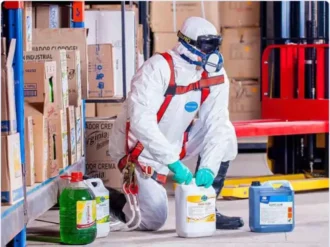Introduction
On average, military work involves greater risk than other occupations. Novel technologies must often be used by employees in a multitude of environments where they haven’t been previously tested. Despite these challenging conditions, military staff can increase their workplace safety through appropriate risk management protocols that facilitate increased risk awareness, as well as specialized training to help combat the latter.
Potential Hazards
Among the most pressing risks faced by military workers are the following:
Contagious Diseases.
Coming in direct contact with blood or blood-stained objects is a common risk for military workers. Although a common sight in field hospitals, blood is just as frequently encountered outside of medical areas. Particularly when the blood’s provenance is unspecified, employees are in jeopardy of exposing themselves to a series of viral, fungal, or other infectious pathogens. Hepatitis B, hepatitis C, and human immunodeficiency virus (HIV) are some of the most dangerous micro-organisms that can easily be transmitted through unprotected interactions with blood.Exposure to Dangerous Weather Conditions.
Military workers are often deployed in environments with hostile weather. This can range from life-threatening cold to dangerous heat, but also sudden and drastic variations from one extreme to another. Quite frequently, the only form of protection an employee has against the latter is their standard equipment and past training. The only way to prevent weather-related injuries, such as frostbite, slips and falls, heat stroke and heat illness, personnel must receive appropriate safety training.Asbestos.
Despite its high toxicity to human health, asbestos was essential in the construction of certain 20th century specialized equipment, including shipyard piping, mining equipment, and more. Although the presence of asbestos is usually signaled for workers, this is not always the case with military staff deployed in foreign territory. In many developing and underdeveloped countries, this noxious compound continues to be used in buildings and other public structures.Exposure to Hazardous Chemicals.
Military workers come in contact with a number of life-threatening chemicals. In countries where waste disposal is impossible, burn pits are employed. The resulting smoke is irritating for respiratory airways and may pose long-term health risks. When traversing foliage and crops, employees will likely come in contact with a range of herbicides and pesticides, most of which may not be as thoroughly regulated or marked. The latter’s impact on human health can range from irritations and allergic reactions to multi-symptom illnesses and chronic diseases.
Incident Prevention
All military workers will ultimately undergo arduous safety training courses before getting assigned to any task that might expose them to occupational hazards. These risks are often so widespread that safety programs must take into account unforeseen conditions when developing risk management protocols. Particularly in new situations and environments, the only way for military employees to stay safe is to develop a safety-oriented mentality.
Although specialized protective gear is not always present, military workers have access to a range of personal protective equipment (PPE) that can be used in order to safeguard against certain risks, such as, for example, when handling blood-stained materials or when traversing areas where herbicides and/or pesticides might be used. The same is true for working in harsh weather conditions.
To prevent accidents from taking place, military personnel have to regularly perform thorough risk assessments in what concerns their working environments. Then, they need to employ any safety protocols and/or PPE that might be useful when working around specific hazards in order to maintain their health.
Recommended Safety Courses



What You Can Do to Stay Safe
Regardless of your specialization, the best way to stay safe as a military employee is to always know the risks that you and your colleagues are exposed to based on your environment and task at hand. To make this possible, your employer should provide access to the necessary safety training.
If, on the other hand, you wish to prepare yourself for a new position or a promotion, you can also individually acquire and complete the required safety courses.

